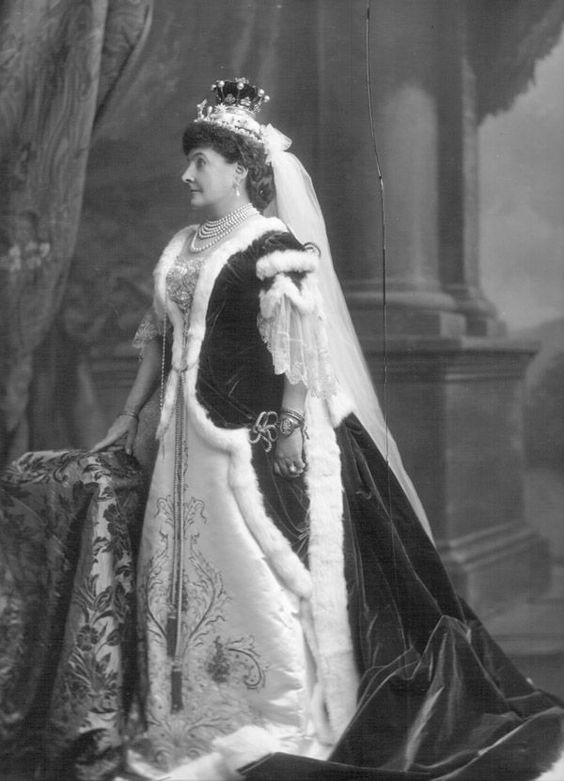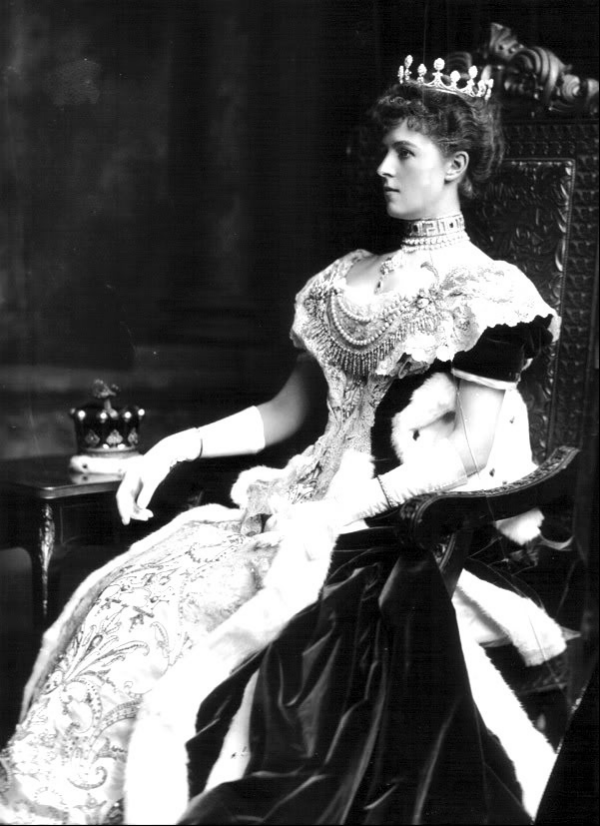 |
| Grand Ladies Site |
Jewel History: Coronation Jewels (1902)
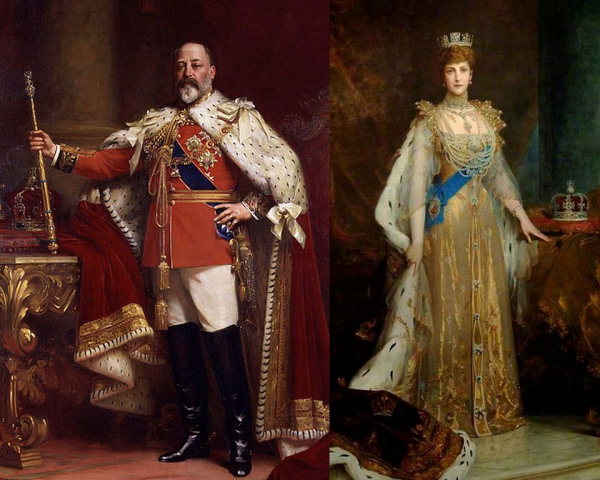 |
| Coronation portraits of King Edward VII and Queen Alexandra by Sir Samuel Luke Fildes (Wikimedia Commons) |
Though King Edward [1] will drag a prodigious train of almost eighteen karat spun gold at his heels, and his Queen [2] will perambulate the famous abbey under a gilt canopy carried by four important duchesses, it is the jewels, royal and individual, that will make for the greatest splendor at the forthcoming coronation.
Queen Alexandra frankly adores precious stones, and King Edward has a very pretty knowledge of good gems; between them they will display on coronation day some magnificent antique and modern specimens, and to help the glitter and the glory of the occasion, the Queen has asked the peeresses to wear their tiaras. The result will undoubtedly be dazzling, for during the past three centuries rich English families, taking advantage of the troubles of their continental neighbors, have bought fine jewelry, and now own the most abundant treasures of this sort of any of the nobility in Europe.
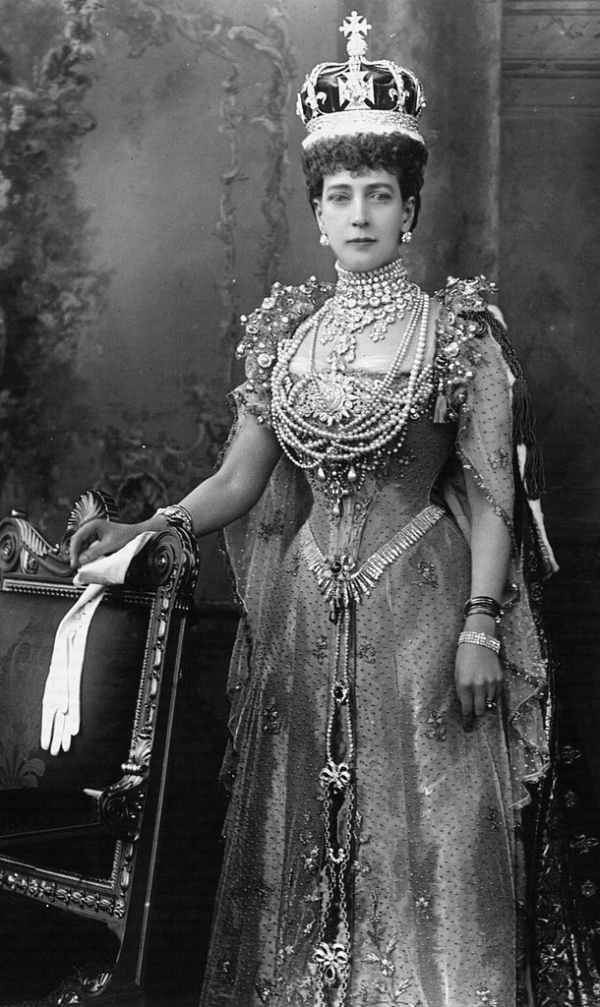 |
| Queen Alexandra in her coronation jewels (Wikimedia Commons) |
For her own part, the Queen of England loves pearls best of all gems, and her robes of state are to be looped and fastened with ropes of pearls. These are her chief pride and pleasure, because some of them are said to have belonged to Mary, Queen of Scotland. They were given her by her husband, King Francis, who had them from his mother, Catherine de Medici [3]. When Mary got into trouble at the hands of Queen Elizabeth, Catherine was eager to get the pearls, but Elizabeth liked pearls too, and secured them for a paltry price. There is no doubting their size and splendor, for in her portrait, the Queen of James I [4], wears some of them, and one, pinned in her hair, looks about the size of a seckel pear. Beside the pearls, Queen Alexandra will wear the Koh-i-Noor [5] set in her crown, and the emerald given Queen Victoria by the Czar of Russia; and amid the priceless lace that is to form the front of her frock will appear all the Hanoverian diamonds [6] set in one dazzling stomacher.
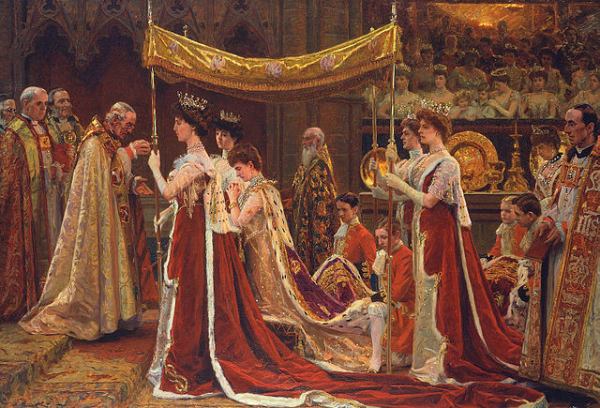 |
| The Anointing of Queen Alexandra at the Coronation of Edward VII by Laurits Tuxen (Wikimedia Commons) |
The finest of the jewels collected by the four Georges and William IV, have been put into her crown, which is to be made only of these stones, with the Koh-i-Noor in the center. The remainder are really sufficiently abundant to serve as spangles for her whole costume. The lace she is to use is from the collection of English royalty. Queen Victoria left to her all Queen Anne’s lace and that of King William III, for the latter loved lace and spent as much as twelve thousand dollars a year on the laces of Italy and Belgium.
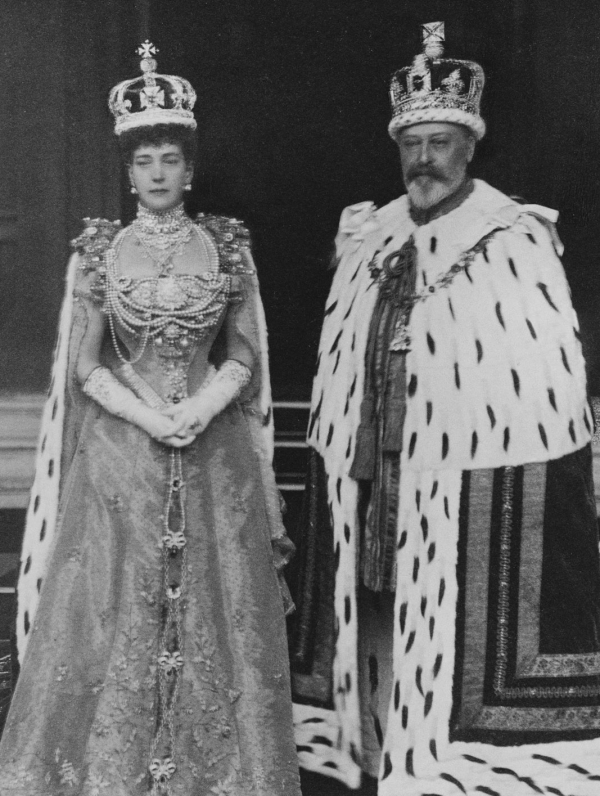 |
| Queen Alexandra and King Edward VII in their coronation robes and crowns (Wikimedia Commons) |
King Edward’s best jewel belongs in his crown, and is the biggest ruby on record [7]. It was given to Edward, the Black Prince, by King Pedro of Castile. In the crown, also, is the famous tear-shaped diamond which Anne Boleyn received from Francis I of France [8]. In Anne’s day it was worth fifteen thousand crowns, and today it is priceless.
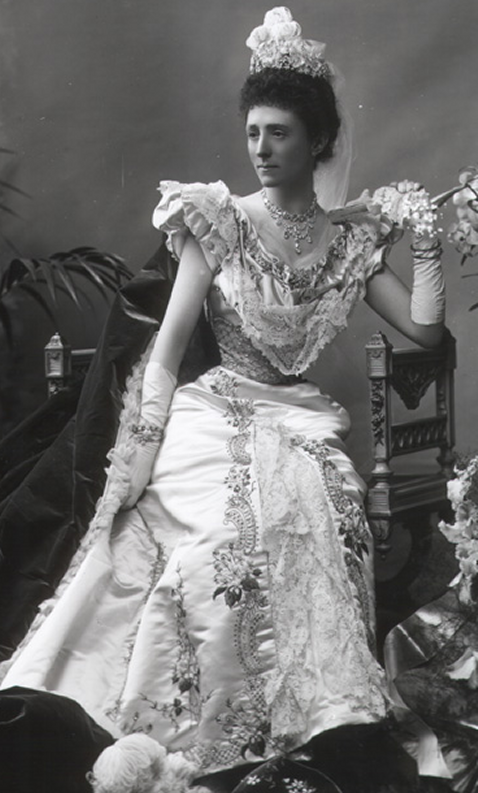 |
| Mary Russell, Duchess of Bedford, ca. 1898 (Wikipedia) |
Many of the nobility of England, however, have collections of precious stones that equal, if not surpass, the crown jewels, and at the coronation the best in their caskets will come forth. The Duchess of Bedford [9] owns the biggest bronze diamond in the world; this is being set at present in a tiara. The Duke of Hamilton [10], who can’t afford to keep the acres of his paternal rooftree in repair, and who consequently seeks, as a rule, safer and more comfortable shelter elsewhere, owns diamonds of such size and such numbers that the wife whom he has lately married [11] could actually afford to have an entire high neck and long sleeved waist covered with them. His mother [12], in a shabby black gown, used to attend the opera with a four-inch wide belt of diamonds about her ample waist, and ever diamond in the belt was fit to set as a solitaire.
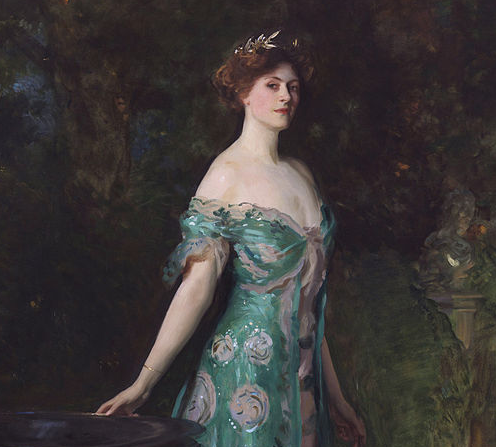 |
| Detail of John Singer Sargent’s Portrait of Millicent Leveson-Gower, Duchess of Sutherland, 1904 (Wikimedia Commons) |
The Duchess of Sutherland [13] will probably take the cake for her opals. Her most treasured stone was originally the property of the Empress Josephine, and was known, because of its gorgeous fire, as the “Burning of Troy.” [14] Nobody knows just how Napoleon got this jewel, but the story runs that he gave it to his wife, who dated all his and her misfortunes from the hour it came into her hands. She sold it just before her death, and it passed into the keeping of the Sutherlands, that have since been a singularly lucky family; so, evidently, an opal can work two ways.
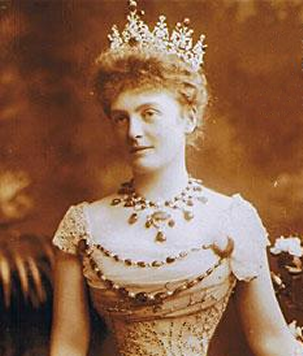 |
| Princess Victor Duleep Singh wears the family’s emeralds |
One of the ladies who will show marvelous and, saving for the Russian crown jewels, incomparable emeralds, is the Princess Duleep Singh [15]. She is an English girl, wedded to the East Indian prince, who was educated in England, and gives his allegiance to the crown, and inherited from his father a sumptuous collection of jewels. All the emeralds of the collection he gave his wife, in the form of a great collar, which falls like a bertha around her shoulders, in a coronet, bracelets, a girdle, and a throat band. These, with brooches, bracelets, and rings of emeralds, she will undoubtedly display at the coronation.
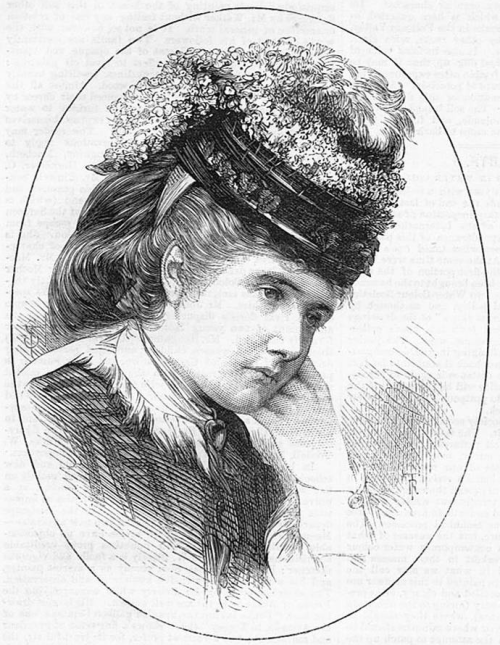 |
| Gwendolen Crichton-Stuart, Marchioness of Bute |
The Marchioness of Bute [16] will lead all the rest who wear rubies. The late Marquess of Bute [17] was rich, in the American millionaire sense, and was one of the most generous buyers known to the European dealers in gems. His collection of rubies includes the noblest stone taken from the Burma mines. It is called the “Heart of Douglass,” because of its size and pure, ruddy color. Set alone, as a pendant, it is usually worn by the Marchioness, whose ruby and diamond tiara is regarded as the most valuable jeweled ornament owned in Europe by a private individual.
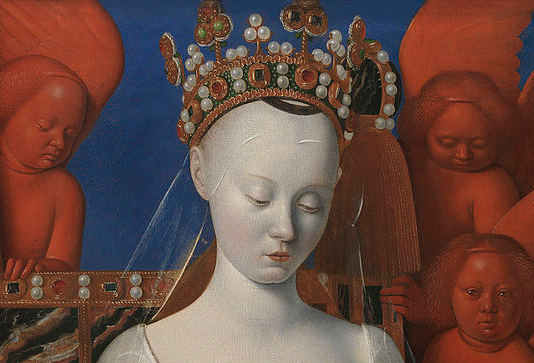 |
| Agnes Sorel in a detail of Fouquet’s Madonna lactans (Wikimedia Commons) |
The finest diamond necklace, made of the greatest number of stones of an imperial size, will be displayed by the Baroness Rothschild [18]. It very nearly conceals her chest and shoulders when worn with a low-cut evening dress, and the apparent weight and discomfort incurred in its wearing recalls the story of the first diamond necklace of which we have any record. It was given to the famous beauty, Agnes Sorel, by her lover, King Charles VIII of France. The fair Agnes complained that the weight and sharp points of the stones chafed the tender flesh of her neck, whereupon the King coined that smart epigram, “Il faut souffrier pour etre belle,” meaning, “you must suffer in order to be beautiful.”
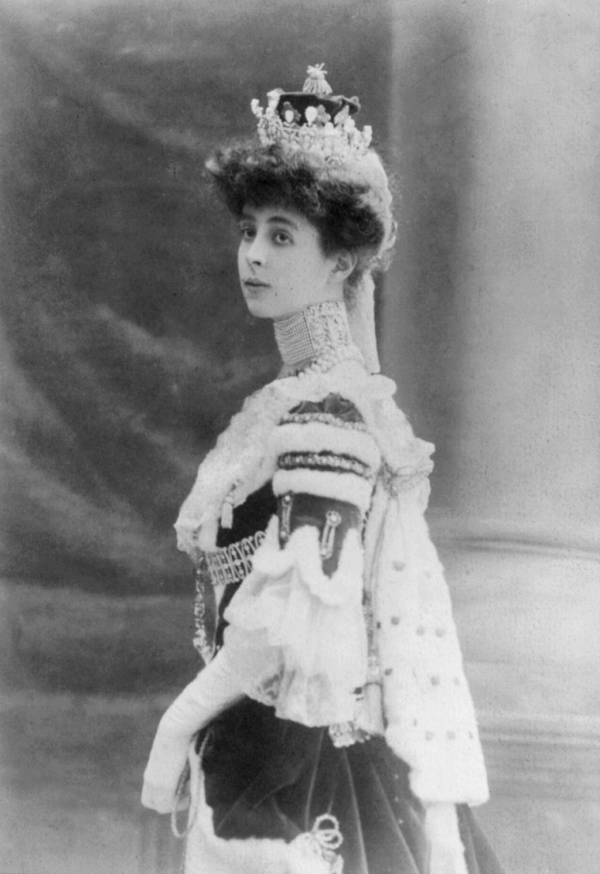 |
| Consuelo Spencer-Churchill, Duchess of Marlborough at the 1902 coronation |
The Duchess of Marlborough [19] will uphold the American reputation for fine jewels with her tiara and her pearl chain that measures twice her length from throat to toes. None of her stones possess any historic value, however, and she will see at the coronation many peeresses who can ill afford to keep a carriage or take a season in London, blossom out at the coronation in entailed family gems that will, for size and number, make her wink.
NOTES
1. King Edward VII of the United Kingdom (1841-1910), the eldest son of Queen Victoria and Prince Albert, became king on his mother’s death in January 1901. His coronation was originally scheduled for June 1902, but two days before the appointed date, he had emergency surgery after being diagnosed with appendicitis. The coronation was rescheduled and took place two months later, on August 9, 1902, 115 years ago today. The Archbishop of Canterbury who crowned him, Frederick Temple, died only a few months after.
2. Queen Alexandra (1844-1925) was the wife of King Edward VII of the United Kingdom. She was born a Danish princess, the eldest daughter of King Christian IX and Queen Louise of Denmark. She married the then Prince of Wales in 1863. The couple had six children, including King George V of the United Kingdom and Queen Maud of Norway.
3. The first husband of Mary, Queen of Scots (1542-1587) was King François II of France, the son of King Henri II and Catherine de Medici. Queen Catherine gave Mary a necklace of black pearls as a wedding present in 1558. After Mary’s abdication in 1567, the pearls were taken by her half-brother, the Earl of Moray. The story goes that both Queen Catherine and Mary’s cousin, Queen Elizabeth I of England, apparently tried to purchase the pearls, and Elizabeth won the bidding war. Some scholars believe these are the black pearls that Elizabeth wore in the famous Armada Portrait. I’ve not found convincing evidence that Queen Alexandra wore these particular pearls at her coronation, but she did wear many strands of pearls on the day.
4. Queen Anne (1574-1619) was the wife of James VI and I. She was the second daughter of King Frederik II and Queen Sophie of Denmark. She married King James in 1589; their children included King Charles I of England and Queen Elizabeth of Bohemia. She wore pearls in numerous official portraits, and most of them feature her wearing large pear-shaped pearls in her hair.
5. The Koh-i-Noor Diamond, found in India and owned by various rulers in Asia for centuries, ended up in the British crown jewel collection in 1850. (How it got there, and whether it was a legal transaction, are questions that are debated hotly to this day.) The diamond was worn by Queen Alexandra, Queen Mary, and Queen Elizabeth (the Queen Mother) in their coronation crowns. It currently remains set in the Queen Mother’s Crown, and can be seen on display today in the Tower of London.
6. Nearly all of the diamonds owned by the British royals that had a documented Hanoverian connection had to be returned to the Hanoverian royal family after a legal decision in 1858. The stomacher that Queen Alexandra wore to her coronation was the Diamond Cockade Brooch, an enormous diamond military hat ornament that was later altered by Alexandra to function as a cloak clasp. The exact provenance of this piece is not known (it was left out of Hugh Roberts’s diamond book), but it’s said to have been owned by Queen Victoria, and it may date further back than that, perhaps to a Hanoverian king like George IV (who did love a bit of bling!).
7. The Black Prince’s Ruby, which is currently set in the Imperial State Crown, is actually a spinel, not a ruby. (In times past, spinels were often falsely believed to be rubies.) It’s also not the biggest spinel (or ruby!) in existence. The stone was presented to the Black Prince (Edward of Woodstock) in the 14th century, making it one of the oldest gemstones in the crown jewel collection.
8. King François I of France presented Anne Boleyn (1501-1536), the second wife of King Henry VIII of England, with a large diamond during Henry and Anne’s visit to Calais in 1532. I’ve never read any evidence that this specific diamond was set in any of the British coronation jewels.
9. Mary Russell, Duchess of Bedford (1865-1937), born Mary Du Caurroy Tribe, was the wife of the 11th Duke of Bedford. She was a noted British philanthropist, aviator, and ornithologist.
10. Alfred Douglas Douglas-Hamilton, 13th Duke of Hamilton and 10th Duke of Brandon (1862-1940) was a sailor who inherited his title and estates from his fourth cousin, the 12th Duke, in 1895. The references here to the loss of family estates have to do in part with the 12th Duke’s will; he left numerous unentailed family properties to his daughter, Lady Mary, who later became the Duchess of Montrose. Mary inherited, for example, Brodick Castle, which had been in the family for five centuries.
11. Nina Douglas-Hamilton, Duchess of Hamilton (1878-1951), born Nina Poore, married the 13th Duke of Hamilton in December 1901. She was a famous activist for animal rights.
12. Elizabeth Douglas-Hamilton (1828-1867), born Elizabeth Ann Hill, was the wife of Captain Charles Douglas-Hamilton (a descendant of the 4th Duke of Hamilton) and the mother of the 13th Duke of Hamilton.
13. Millicent Leveson-Gower, Duchess of Sutherland (1867-1955), born Lady Millicent St. Clair-Erskine, was the daughter of 4th Earl of Rosslyn and the wife of the 4th Duke of Sutherland. She was one of the canopy bearers at this coronation. She was also a novelist, playwright, and social reformer.
14. The Burning of Troy Opal, given to Josephine by Napoleon, was reportedly an enormous black opal that flashed red fire. The opal seems to have been either hidden away or lost after Josephine’s death, and I’ve never read any link between the opal and the Sutherlands.
15. Princess Victor Duleep Singh (1877-1956), born Lady Anne Coventry, was the wife of Prince Victor Duleep Singh (son of the last Maharajah of Lahore) and the daughter of the 9th Earl of Coventry. Their marriage in 1898 was the first union of an Indian prince and an English aristocrat; Queen Victoria attended the wedding.
16. Gwendolen Crichton-Stuart, Marchioness of Bute (1854-1932), born the Hon. Gwendolen Fitzalan-Howard, was the wife of the 3rd Marquess of Bute and the daughter of Edward Fitzalan-Howard, 1st Baron Howard of Glossop (who was himself a son of the 13th Duke of Norfolk).
17. John Crichton-Stuart, 3rd Marquess of Bute (1847-1900) was reportedly one of the richest men in the world during his lifetime, and he became an important architectural patron. His conversion to Catholicism reportedly scandalized Victorian society, leading Benjamin Disraeli to use him as a model for the hero of the novel Lothair. He died in October 1900.
18. Emma Rothschild, Baroness Rothschild (1844–1935), born Emma von Rothschild, was the wife (and cousin) of Nathan Rothschild, 1st Baron Rothschild, a member of the famous banking family. Her husband was appointed a Privy Counsellor by King Edward VII in the 1902 Coronation Honours.
19. Consuelo Spencer-Churchill, Duchess of Marlborough (1877-1964), born Consuelo Vanderbilt, later Consuelo Balsan. The daughter of William K. and Alva Vanderbilt, Consuelo was reportedly pushed into an unhappy marriage with the 9th Duke of Marlborough by her socially ambitious mother. After the birth of two children, the Marlboroughs separated in 1906 and divorced in 1921.
The Daily Diadem: Lady Shrewsbury’s Coronation Tiara
